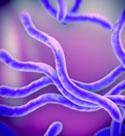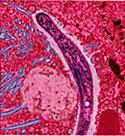Insect-Borne Diseases
You may just see insects such as mosquitoes and ticks as mere annoyances that leave behind itchy bites, but beyond being bothersome, these insects can also carry diseases that cause thousands of illnesses and deaths each year. Fortunately, you can reduce the risk of contracting insect-borne diseases by implementing effective insect control systems. TERRO® offers a wide selection of products to provide long-lasting protection for your home and family. Learn more about insect-borne diseases below.

Lyme Disease
What is Lyme Disease?
According to the CDC, Lyme disease is the most common vector-borne disease in the United States. Lyme disease is caused by a bacterium called, Borrelia burgdorferi, which is then transmitted to humans via several types of blacklegged ticks. The best bet for preventing Lyme disease is to check yourself and your clothes thoroughly for ticks immediately after spending time outdoors.
How Does Lyme Disease Spread?
Lyme disease is transmitted to people by ticks. The disease is typically contracted from immature ticks, otherwise known as nymphs. This is because nymphs are incredibly small and hard to see, making timely tick removal less likely. Adult ticks also carry the disease but are more likely to be quickly discovered and removed because of their larger size. Ticks generally need to be attached to their human host for 36 to 48 hours to transmit the bacteria and infect a person with Lyme disease.
There is no evidence that Lyme disease can be passed from person to person, except during pregnancy from mother to unborn child if the disease is left untreated.
What are the Symptons of Lyme Disease?
In the early stages of infection, people usually experience symptoms such as fever, chills, fatigue, headache, muscle and joint aches and Erythema migrans rash or swollen lymph nodes. EM rash appears anywhere from 3 to 30 days after the bite, usually at the site of the tick bite but not always. Over the course of a few days, the rash expands up to 12 inches in diameter or more. The rash sometimes has a bull’s eye appearance as it expands.
If left untreated, Early Lyme disease can progress to Late Lyme disease, which is more serious. These symptoms do not begin appearing until weeks or months after a bite from an infected tick. Symptoms include severe headaches and neck stiffness, additional EM rashes, severe joint pain and joint swelling, facial palsy, dizziness or shortness of breath, heart palpitations, nerve pain, shooting pains, numbness, and inflammations of the brain and spinal cord.
How is Lyme Disease Treated?
People with Early Lyme disease are treated with antibiotics, and usually recover quickly and completely. Antibiotics commonly used for oral treatment include doxycycline, amoxicillin, or cefuroxime axetil. Some patients may have recurrent symptoms and require another course of antibiotics to clear the infection. There is currently no vaccine for Lyme disease.
Learn More about Lyme Disease »

Malaria
What is Malaria?
Malaria is a potentially deadly disease that’s caused by parasites and is transmitted by mosquitoes. There are a few parasites that cause the disease and each parasite causes slightly different symptoms. The parasite gets into your liver and bloodstream, causing the disease. Malaria is mostly eradicated in developed countries. Most cases in the United States are caused by people traveling to affected countries.
How Does Malaria Spread?
Malaria is a blood disease spread from person to person by the bite of the Anopheles mosquito. When a mosquito bites an infected person, the mosquito is then infected by the malaria parasite. When the now infected mosquito bites other people, the malaria parasite is transmitted to them.
The disease can also be spread other ways through the blood, such as through a pregnant mother to an unborn child, or by sharing needles.
What are the Symptoms of Malaria?
Early symptoms of malaria can look a lot like the flu. Patients may experience symptoms such as chills, headache, sweating, aches, diarrhea, fever, nausea, general fatigue and malaise. Malaria symptoms can develop as early as 6 days after exposure or a mosquito bite. In some cases, symptoms can develop months after someone has returned home from a malaria-affected area.
If complications occur, malaria can quickly move from flu-like symptoms to something deadly. Complications can include kidney failure, anemia, coma, low blood sugar, respiratory issues, spleen problems, low blood pressure, jaundice, and seizures. At this point, malaria becomes a medical emergency. Even once the first symptoms pass, some malaria parasites can stay in the liver and can cause relapses every few years.
How is Malaria Treated?
It’s important to get proper treatment for malaria immediately. Left untreated, the disease can get worse. If complications happen, malaria can prove fatal. Young children, the elderly, pregnant women, and those affected by serious disease face a higher risk of being unable to fight off the disease.
The exact treatment you get will depend on a few things, including your medical history, your symptoms, and the type of malaria parasite you have. If you are diagnosed with malaria, your doctor will likely prescribe some form of medication. One big problem with treatment is that some malaria parasites have become drug-resistant, so you might have to change medication if one treatment is not working or your symptoms get worse.

West Nile Virus
What is West Nile Virus?
West Nile Virus is the leading mosquito-borne disease in the United States, according to the CDC. Mosquitoes began transmitting West Nile Virus in the U.S. around 1999. The virus was first found in humans living in the New York area, but it has since spread across the entire United States.
How Does West Nile Virus Spread?
Mosquitoes contract the virus when they bite birds infected with the disease. Birds can become infected through mosquito bites as well. Some birds, such as hawks, owls, and other scavengers, can contract the virus from eating other dead birds. There is no evidence that people can contract West Nile directly from handling or eating infected birds. West Nile does not pass from person to person, except in rare cases from blood transfusion, organ transplants, or from mothers to babies during pregnancy or delivery.
What are the Symptoms of West Nile Virus?
miting, diarrhea, or rash. Very few people infected with West Nile Virus experience severe illness affecting the nervous system, such as encephalitis or meningitis. Severe symptoms include high fever, neck stiffness, disorientation, and numbness. Recovery from severe illness could take weeks or month, with some of the effects to the nervous system being permanent. Only about 1% of people who develop severe illness die.
How is West Nile Virus Treated?
There are no vaccines or specific prescription treatments available for West Nile Virus. For sufferers with mild symptoms, over-the-counter pain medications may be used to relieve some symptoms or reduce fever. Sufferers with severe symptoms often need to be hospitalized.
Learn More about West Nile Virus »

Zika
What is Zika?
The Zika virus is one of several tropical mosquito-borne diseases. Though the disease has been around since 1947, the world has seen a strong increase in the number of infections and complications involving this virus since 2015, especially in parts of South and Central America — particularly in Brazil. The virus is closely related to the West Nile virus, dengue, and yellow fever.
How Does Zika Spread?
Zika is spread mostly by the bite of an infected Aedes aegypti (Yellow Fever mosquito) or Aedes albopictus (Asian tiger mosquito). When a mosquito bites an infected person, they become a carrier of the disease and can spread it to other people as they continue to bite. Mosquito bites are the most common way the disease spreads, but the disease can also be passed from a pregnant woman to her unborn child, leading to certain birth defects as well.
What are the Symptoms of Zika?
People infected with Zika virus often don’t experience any symptoms at all. If they do experience symptoms, they are often mild and may include fever, rash, headache, joint pain, red eyes (conjunctivitis), and muscle pain. The symptoms may last from several days to a week.
How is Zika Treated?
There is no specific treatment prescribed to treat the virus. You can however treat the symptoms with over-the-counter medicines to reduce fever and pain. Also be sure to drink fluids and get plenty of rest.
